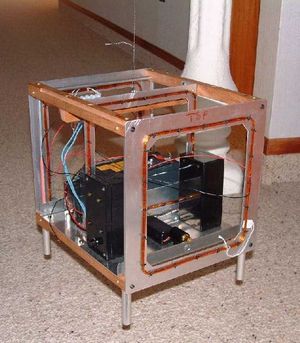The KiwiSAT "Science Package" - Massey University Involvement
ADAC - Atitude Determination And Control
This on-board experiment explores aspects of the fine attitude control of a small satellite by interaction with the earth's magnetic field.
Originally planned as a dual purpose experiment (to also include a simple ozone measurement tool) it was decided to avoid 'splitting the aim' and to concentrate fully on a low cost Attitude Determination and Control System.
This, it was thought, would provide a 'safe' (KISS!) but interesting objective for a first AMSAT-ZL satellite and would at the same time enable us to establish just what level of pointing accuracy could be achieved by simple equipment and smart software. More …
Ground based experiments have demonstrated that the attitude can be precision controlled by means of pulsed magnatorquers to enable the unit to be rotated at various speeds and stopped in selected directions.
The end aim is to be able to have the on-board computer (IHU) command the satellite to adopt a specific attitude.
If this can be achieved it opens great possibilities for low-cost low-risk satellites which could monitor distant events or enable special communications experiments using high gain/narrow beam width antenna.
An advantage of this command ability will be to enable fine control of the satellite's spin axis and rate of rotation.
Meet the ADAC experiment development team at Massey University!
KiwiSAT Scientific Experiment #2
Ionospheric Research Project
Overview:
By the addition of a 470 MHz beacon phase locked to the 2 metre beacon, KiwiSAT will provide a dual coherent beacon system for ionosheric reasearch of both the Total Electron Content (TEC) and Faraday Rotation in the KiwiSAT to ground path. More..
